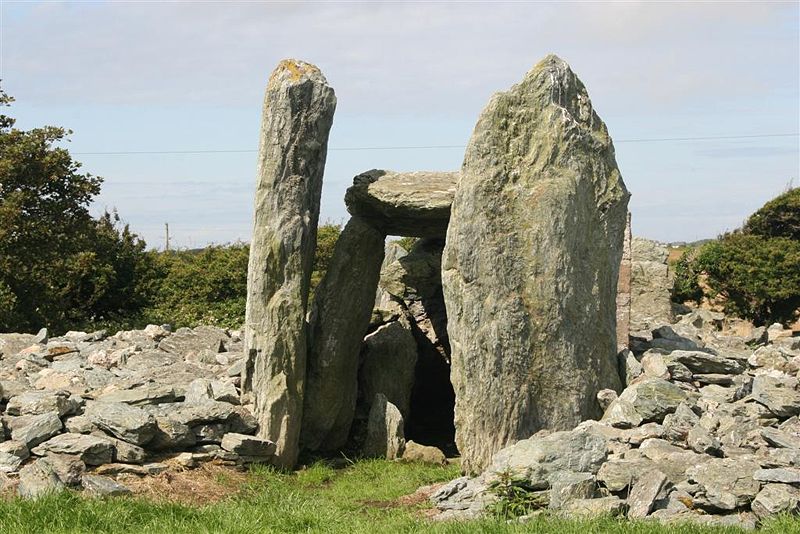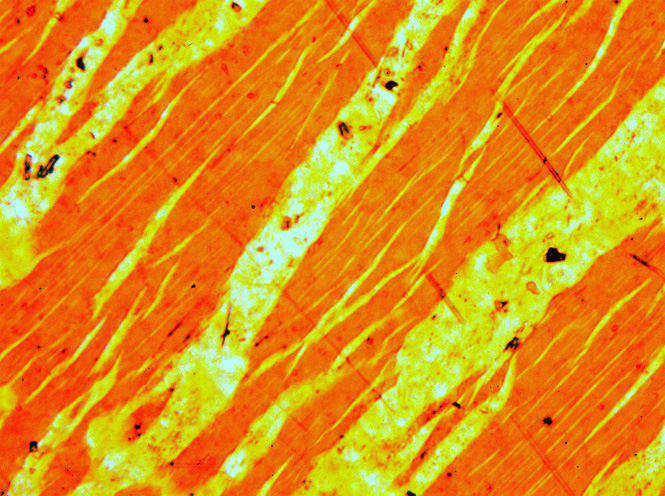|
Trefignath
Trefignath is a Neolithic burial chamber near Trearddur, south of Holyhead on Holy Island, off Anglesey in Wales. In its most complete form it included a large cairn covering three stone tombs, set on a small knoll. It was excavated between 1977 and 1979, revealing several phases of occupation with three separate burial chambers built in succession. It is a scheduled ancient monument, maintained by Cadw. Trefignath is adjacent to an alignment of small standing stones which extends some 350 metres northwestwards. Beyond these, some 450 metres from Trefignath, is the larger Tŷ Mawr Standing Stone. Geology Ecological development The site is on a small rocky knoll. It is close to a marshy area, Trefignath peat bog (mostly filled in when the railroad to Holyhead was built). Pollen preserved in the peat records the changes of vegetation since the Ice Age; the sequence begins with sub-arctic post-glacial shrubs with grasses and other herbs, through the early development of fores ... [...More Info...] [...Related Items...] OR: [Wikipedia] [Google] [Baidu] |
Trefignath From The North-west
Trefignath is a Neolithic chamber tomb, burial chamber near Trearddur, south of Holyhead on Holy Island, Anglesey, Holy Island, off Anglesey in Wales. In its most complete form it included a large cairn covering three stone tombs, set on a small knoll. It was excavated between 1977 and 1979, revealing several phases of occupation with three separate burial chambers built in succession. It is a Scheduled monument, scheduled ancient monument, maintained by Cadw. Trefignath is adjacent to an alignment of small standing stones which extends some 350 metres northwestwards. Beyond these, some 450 metres from Trefignath, is the larger Tŷ Mawr Standing Stone. Geology Ecological development The site is on a small rocky knoll. It is close to a marshy area, Trefignath peat bog (mostly filled in when the railroad to Holyhead was built). Pollen preserved in the peat records the changes of vegetation since the Ice Age; the sequence begins with sub-arctic post-glacial shrubs with grasses a ... [...More Info...] [...Related Items...] OR: [Wikipedia] [Google] [Baidu] |
Trefignath Burial Chambers, Small Adult On Site Of Middle, Second Chamber
Trefignath is a Neolithic burial chamber near Trearddur, south of Holyhead on Holy Island, off Anglesey in Wales. In its most complete form it included a large cairn covering three stone tombs, set on a small knoll. It was excavated between 1977 and 1979, revealing several phases of occupation with three separate burial chambers built in succession. It is a scheduled ancient monument, maintained by Cadw. Trefignath is adjacent to an alignment of small standing stones which extends some 350 metres northwestwards. Beyond these, some 450 metres from Trefignath, is the larger Tŷ Mawr Standing Stone. Geology Ecological development The site is on a small rocky knoll. It is close to a marshy area, Trefignath peat bog (mostly filled in when the railroad to Holyhead was built). Pollen preserved in the peat records the changes of vegetation since the Ice Age; the sequence begins with sub-arctic post-glacial shrubs with grasses and other herbs, through the early development of fores ... [...More Info...] [...Related Items...] OR: [Wikipedia] [Google] [Baidu] |
Holy Island, Anglesey
Holy Island ( cy, Ynys Gybi, 'the island of (Saint) Cybi') is an island () on the western side of the larger Isle of Anglesey, Wales, from which it is separated by the Cymyran Strait. It is called "Holy" because of the high concentration of standing stones, burial chambers, and other religious sites on the small island. The alternative English name of the island is Holyhead Island. According to the 2011 UK Census, the population was 13,659, of which 11,431 (84%) lived in the largest town, Holyhead. History Irish pirates invaded Anglesey following the end of Roman rule in Britannia. Cunedda first began warfare against the Irish but ultimately Cadwallon Lawhir defeated the Irish on Holy Island. Natural features There are a variety of natural habitats on the island including mudflats, dunes, marshes, and beaches. Practically nothing is left of the oak forest that covered almost all of the island before the arrival of Neolithic farmers. The western side of the isla ... [...More Info...] [...Related Items...] OR: [Wikipedia] [Google] [Baidu] |
Ericales
The Ericales are a large and diverse order of dicotyledons. Species in this order have considerable commercial importance including for tea, persimmon, blueberry, kiwifruit, Brazil nuts, argan, and azalea. The order includes trees, bushes, lianas, and herbaceous plants. Together with ordinary autophytic plants, the Ericales include chlorophyll-deficient mycoheterotrophic plants (e.g., '' Sarcodes sanguinea'') and carnivorous plants (e.g., genus ''Sarracenia''). Many species have five petals, often grown together. Fusion of the petals as a trait was traditionally used to place the order in the subclass Sympetalae. Mycorrhizal associations are quite common among the order representatives, and three kinds of mycorrhiza are found exclusively among Ericales (namely, ericoid, arbutoid and monotropoid mycorrhiza). In addition, some families among the order are notable for their exceptional ability to accumulate aluminum. Ericales are a cosmopolitan order. Areas of distribution of fa ... [...More Info...] [...Related Items...] OR: [Wikipedia] [Google] [Baidu] |
Ty Mawr Stone Near Trefignath,small Adult For Scale
Ty (stylized as ty) is an American multinational corporation headquartered in Oak Brook, Illinois, a suburb of Chicago. It was founded by Ty Warner in 1986. It designs, develops and sells products, most notably Beanie Babies, exclusively to specialty markets worldwide. Internet First business-to-consumer Website Ty was the first business to produce a direct-to-consumer website designed to engage their market. This is a major contributing factor to the early and rapidly growing popularity of Beanie Babies. By the time the first iteration of the Ty Web site was published in late 1995, only 14% of Americans were using the Internet. In tandem with the launch of the Ty Website, all Beanie Baby hangtags had the Ty Website URL and a call to action printed underneath the poems and birthdays that commanded audiences to visit the company Web site with text that read: ''Visit our web page!!!'' As a result, consumers were visiting the Ty Web site by the thousands to gain information ab ... [...More Info...] [...Related Items...] OR: [Wikipedia] [Google] [Baidu] |
Peterborough Ware
Peterborough ware is a decorated pottery style of the early to middle Neolithic. Named after the region of Middlesex and East Anglia, England where the style was first discovered, it is known for the impressed pits made by bone or wood implements in its sides. Whipped cord was also used to make circular 'maggot' patterns. Ebbsfleeet ware, Fengate ware and Mortlake ware have been identified as subdivisions of Peterborough ware. The term was introduced by R.A. Smith based on examples found at Fengate, near Peterborough. It originally referred to all neolithic impressed ware, without restricting by location, but now primarily refers to finds of this type in southern and eastern England. The earliest form of Peterborough ware is known as Ebbsfleet style and had minimal decoration, although this later became more complex. Peterborough ware may have evolved from the earlier Grimston-Lyles Hill ware, around 3500 BC. Later varieties are known as Mortlake and Fengate sub-styles althoug ... [...More Info...] [...Related Items...] OR: [Wikipedia] [Google] [Baidu] |
Passage Grave
A passage grave or passage tomb consists of one or more burial chambers covered in earth or with stone, and having a narrow access passage made of large stones. These structures usually date from the Neolithic Age, and are found largely in Western Europe. When covered in earth, a passage grave is a type of burial mound which are found in various forms all over the world. When a passage grave is covered in stone, it is a type of cairn. Construction and design The building of passage graves was normally carried out with megaliths along with smaller stones. The earliest passage tombs seem to take the form of small dolmens, although not all dolmens are passage graves. The passage itself, in a number of notable instances, is aligned in such a way that the sun shines through the passage, into the chamber, at a significant point in the year, often at sunrise on the winter solstice or at sunset on the equinox. Many later passage tombs were constructed at the tops of hills or mountains, i ... [...More Info...] [...Related Items...] OR: [Wikipedia] [Google] [Baidu] |
Granite
Granite () is a coarse-grained ( phaneritic) intrusive igneous rock composed mostly of quartz, alkali feldspar, and plagioclase. It forms from magma with a high content of silica and alkali metal oxides that slowly cools and solidifies underground. It is common in the continental crust of Earth, where it is found in igneous intrusions. These range in size from dikes only a few centimeters across to batholiths exposed over hundreds of square kilometers. Granite is typical of a larger family of ''granitic rocks'', or '' granitoids'', that are composed mostly of coarse-grained quartz and feldspars in varying proportions. These rocks are classified by the relative percentages of quartz, alkali feldspar, and plagioclase (the QAPF classification), with true granite representing granitic rocks rich in quartz and alkali feldspar. Most granitic rocks also contain mica or amphibole minerals, though a few (known as leucogranites) contain almost no dark minerals. Granite is ... [...More Info...] [...Related Items...] OR: [Wikipedia] [Google] [Baidu] |
Biotite
Biotite is a common group of phyllosilicate minerals within the mica group, with the approximate chemical formula . It is primarily a solid-solution series between the iron- endmember annite, and the magnesium-endmember phlogopite; more aluminous end-members include siderophyllite and eastonite. Biotite was regarded as a mineral ''species'' by the International Mineralogical Association until 1998, when its status was changed to a mineral ''group''. The term ''biotite'' is still used to describe unanalysed dark micas in the field. Biotite was named by J.F.L. Hausmann in 1847 in honor of the French physicist Jean-Baptiste Biot, who performed early research into the many optical properties of mica. Members of the biotite group are sheet silicates. Iron, magnesium, aluminium, silicon, oxygen, and hydrogen form sheets that are weakly bound together by potassium ions. The term "iron mica" is sometimes used for iron-rich biotite, but the term also refers to a flaky micaceou ... [...More Info...] [...Related Items...] OR: [Wikipedia] [Google] [Baidu] |
Perthite
Perthite is used to describe an intergrowth of two feldspars: a host grain of potassium-rich alkali feldspar (near K-feldspar, KAlSi3O8, in composition) includes exsolved lamellae or irregular intergrowths of sodic alkali feldspar (near albite, NaAlSi3O8, in composition). Typically, the host grain is orthoclase or microcline, and the lamellae are albite. If sodic feldspar is the dominant phase, the result is an antiperthite and where the feldspars are in roughly equal proportions the result is a mesoperthite. The intergrowth forms by exsolution due to cooling of a grain of alkali feldspar with a composition intermediate between K-feldspar and albite. There is complete solid solution between albite and K-feldspar at temperatures near 700 °C and pressures like those within the crust of the Earth, but a miscibility gap is present at lower temperatures. If an alkali feldspar grain with an intermediate composition cools slowly enough, K-rich and more Na-rich feldspar domains se ... [...More Info...] [...Related Items...] OR: [Wikipedia] [Google] [Baidu] |






